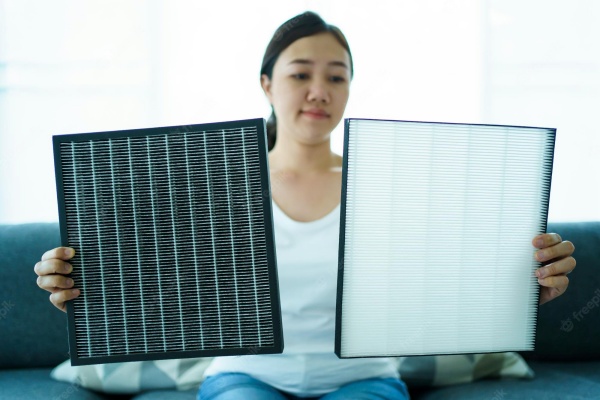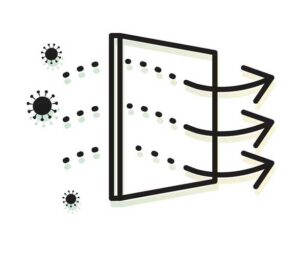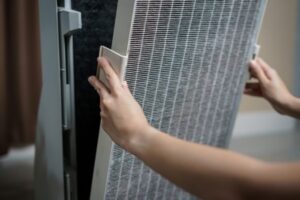
Beginners Guide to HEPA Filters
What is a HEPA filter, and how does it work?
You might have seen those commercials for air purifiers with the happy couple lounging in a clean white living room, taking deep breaths of purified air. It’s easy to be lured into thinking you need one of those machines to live a healthy life, but do you? If you’re new to the world of air purification, don’t worry – we’re here to help. This post will introduce you to HEPA filters and explain why they might be worth your investment. Stay tuned for more tips on how to keep your home’s air clean!
What is a HEPA Filter?
“HEPA” stands for “high-efficiency particulate air” (filter). When scientists developed the atomic bomb, HEPA air filters were invented in the 1940s. They are simply a mat of randomly aligned fibres made from either glass or synthetic materials. The synthetic material used in the air filter is similar to what’s used in quick-dry T-shirts. HEPA filters are effective at trapping particles because they have minimal gaps between the fibres. Particles trying to pass through the filter will become caught in these gaps—substances from passing through. HEPA filters must meet specific standards to be classified as such. The bar is that it must be able to trap at least 99.97% of particles that are 0.3 microns in diameter. A micron is one-millionth of a meter, which means they can capture viruses, germs, pollen, PM2.5, allergies, and other contaminants. The most critical component of any air purifier is the HEPA air filter.
Define Microns:

A micron, generally speaking, is one-millionth of a meter. In other words, it’s a minimal unit of measurement. You’re probably most familiar with the term from its use in describing particles; high-efficiency particulate air (HEPA) filters, for example, are designed to remove particles that are 0.3 microns or larger from the air. That might not seem like much, but when you consider that the diameter of a human hair is about 100 microns, you can see how tiny 0.3 microns is! The bottom line is that microns help measure little things – like particles in the air – and they play an essential role in ensuring that the air we breathe is clean and healthy.
The Standards of HEPA Filters
High-efficiency particulate air (HEPA) is an official government and industrial (non-consumer) standard defined by the U.S. Department of Energy (DOE), but there are also European standards. It’s important to note that the standard does not determine how the filter must be made or what it should be. Still, it indicates that it can trap specific particle diameters and types. The holes in a HEPA filter are tiny – just 0.3 microns in diameter. That’s smaller than human hair, around 50 microns in diameter. For comparison, a piece of paper is about 100 microns thick. That means HEPA filters can capture 99.97% of all particles that are 0.3 microns in diameter or larger.
Particles HEPA Filters Remove
A high-efficiency particulate air (HEPA) filter is a type of air filter that is designed to remove 99.97% of airborne particles that are 0.3 microns in size or larger. HEPA filters are commonly used in various settings, including hospitals, homes, and office buildings. These filters capture many common particles, including pollen, dirt, dust, moisture, bacteria, and viruses. Additionally, HEPA filters can also capture submicron liquid droplets. While HEPA filters are very effective at capturing common particles, they cannot capture gaseous pollutants like chemicals, fumes, gases, and odours. Additionally, they do not affect odours or volatile organic compounds (VOCs).
How HEPA Filters Work
Said HEPA filters catch air pollutants in a sophisticated web of fibres. This can occur in four ways, depending on particle size: inertial impaction, diffusion, interception, or sieving.
Diffusion
Diffusion is the spontaneous mixing of substances caused by the movement of their particles. Particles smaller than 0.3 m are caught at reduced airflow owing to gas molecules colliding with tiny particles (0.1 m).
Interception
This is referred to as interception, when a dust particle follows the air but still comes into touch with the fibre as it passes. This depends on the fibre and is boosted when the fibre’s size is closest to the particle’s size. The majority of mid-sized particles are intercepted.
Impaction
Larger particles cannot evade fibres as they curve through the air; thus, they must embed directly in a fibre.
Sieving
The airflow transports a particle between two fibres. Still, the particle is too big for the space and thus becomes entangled.
Types of HEPA Filters
There are various types of HEPA filters. True HEPA filters should meet DOE criteria for HEPA filtration.
True HEPA Filtration
High-Efficiency Particulate Air (HEPA) filters are designed to remove microscopic particles from the air. The HEPA standard is set by the U.S. Department of Energy (DOE), and it requires that a filter remove 99.97 per cent of all particles that are 0.3 microns in size. This is an incredibly high-efficiency level, which means that a HEPA filter can effectively remove many different types of pollutants from the air.
Absolute HEPA Filters
Absolute HEPA, also known as high-efficiency particulate air, is a type of air filter with a higher filtration power than True HEPA. Absolute HEPA filters are typically used in environments where there is a need for high cleanliness levels, such as in hospitals or laboratories. The main difference between True HEPA and Absolute HEPA is the size of the particles that each filter can remove from the air. True HEPA filters are designed to remove particles that are 0.3 microns in size. In comparison, Absolute HEPA filters are designed to remove particles that are 0.1 microns in size.
Ultra HEPA Filter
Some manufacturers employed UltraHEPA, stating that their product is “100x more effective than HEPA air filters,” capable of removing particles as small as 0.003 microns. This is technically impossible and may constitute deceptive marketing.
HEPA Silent
HEPASilent is a proprietary filter with a trademark that combines electrostatic charge with a mechanical filter. The charge in this filter is meant to make particles cling to the filter fibres more probable.
Permanent HEPA Filter
Although permanent filters can be washed and reused rather than replaced, they are touted as having a HEPA grade. It is not advised to wash HEPA filters since, over time, the washing process may cause the filters’ efficiency to decline.
Why Should You Consider HEPA Filters?

These filters are often used in homes and businesses where people have severe allergies or asthma or where there is a need to keep the air clean for medical reasons. HEPA filters work by trapping particles in a network of fibres. The fibres are so tightly woven that even the smallest particles cannot pass through them. As a result, HEPA filters can remove up to 99.97% of particles from the air, making them an extremely effective way to improve indoor air quality. If you or someone you love suffers from allergies or asthma, or if you are caring for a loved one who is ill, a HEPA filter may be able to help you create a cleaner, healthier environment with better indoor air quality.
Conclusion
HEPA filters are incredibly efficient at removing particles from the air, making them an excellent choice for people who suffer from allergies or asthma. They work by trapping particles in a fibre network, preventing even the smallest particles from passing through. As a result, HEPA filters can remove up to 99.97% of particles from the air, making them an extremely effective way to improve indoor air quality. If you are looking for a way to create a cleaner, healthier environment for yourself or someone you love, consider investing in an air purifier utilizing a HEPA filter.
Last Updated on
- Features to look for in an exhaust fan - September 26, 2022
- How to calculate CFM for exhaust fan - September 24, 2022
- Kitchen Fan Installation – Everything You Need to Know - September 20, 2022
